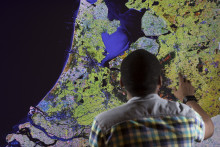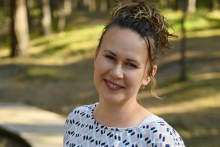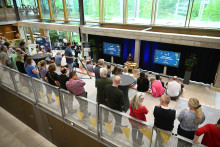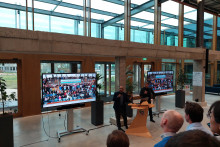Unlike ‘regular’ hunger, which you might experience if you don’t consume enough food, hidden hunger is caused by an insufficient uptake of nutrients. In other words, you might eat enough but your body still doesn't receive the essential vitamins and minerals it needs.
‘Hidden hunger is a global problem. It exists in both developed and developing countries,’ explains Mariana Belgiu, Associate Professor in the Department of Earth Observation Science at the ITC faculty. ‘Especially in rural areas of developing countries, people often consume only what they produce. This means that their diet is not diverse enough to provide all the nutrients. Moreover, the crops themselves are often deficient in important nutrients such as zinc, magnesium, iron and so on.’
‘I felt very strongly that I didn’t want any children and mothers to suffer from malnutrition’
All this leads to hidden hunger, which mainly affects vulnerable groups - women of reproductive age and children. ‘Due to this form of malnutrition, children can have serious health problems including impaired physical development and immune disfunction,’ adds Belgiu. ‘Malnutrition can also impact their cognitive development and mental capacities.’
This motivated Belgiu to look deeper into the topic. ‘I discovered this topic in 2018 and I realized that this was a global food security challenge that needed to be studied. Moreover, I happened to be pregnant with my daughter that year. I felt very strongly that I didn’t want any children and mothers to suffer from malnutrition.’
Climate change
Despite its global impact, hidden hunger has not been properly studied yet. ‘In the past, studies inspired by the Green Revolution focused on boosting agricultural production to make sure there was enough food to feed a rapidly growing population, but we paid less attention to nutrients,’ explains the UT scientist.
The challenge, however, is becoming more and more relevant,says Belgiu. ‘We know that climate change impacts the nutrient content of crops. And that is something that will affect us all,’ says Belgiu. ‘It is believed that the increase in temperatures and CO2 will lead to a dilution of nutrients in the final agriculture production. In other words, the crops will not have enough nutrients.’
Satellites and AI
According to the ITC researcher, there is a clear need to start measuring nutrients in crops and map hidden hunger on a large scale, but this is currently very expensive. The ITC researcher therefore started developing a more cost-effective method using remote sensing technologies and geospatial data.
‘Satellite images provide a lot of spectral information, which allow us to measure the biochemical and biophysical properties of plants,’ explains Belgiu (pictured on the right). On top of satellite data, the researchers also take spectral measurements and gather samples directly in the field. Over time, however, the method should rely only on satellite measurements and other relevant spatially explicit information that allow mapping and monitoring across large areas and time.
‘First we need to verify what can and cannot be measured from space – and why,’ says the scientist. ‘We use very intelligent machine learning algorithms, combined with the samples and satellite measurements from the same location. This way the algorithms can be trained to study the relationships and sense micronutrient deficiencies based on information from space.’
Living lab on campus
Belgiu is starting a ten year long experiment directly on campus of the University of Twente. ‘In collaboration with the UT Climate Centre, we will plant wheat on one of the fields available in the ITC Living innovation lab (LILa) and we will assess the impact of environmental conditions including extreme events such as droughts on its nutrient concentrations over the next ten years. We plan to start this experiment in the fall because these long-term measurements are truly needed.’
‘Even us, people in developed countries, might end up eating food with no nutritional benefits’
Experiments
In her first project funded by the European Space Agency, Belgiu was already able to show that this method can be used to estimate the concentrations of some nutrients in grains. Now she is running several more studies, including an experiment in a greenhouse in the Netherlands, aiming to assess the impact of water deficiency on nutrients. Her team is also looking into helping farmers by predicting the nutrient content early in the growing season.
‘We are working in Italy, Germany and Ethiopia, trying to cover as many climatical zones as possible. It’s important because every location is impacted by its environmental factors and agricultural practices, such as the use of fertilizers,’ explains the Associate Professor. ‘My dream is to have a worldwide network dedicated to these measurements,’ says Belgiu. ‘This is research that needs to be done across many different climatic zones and across time, so that we can get a better understanding of the impact of climate change.’
Global problem
The ITC researcher states that hidden hunger is a global problem that doesn’t only impact developing countries. ‘Even us, people in developed countries, might end up eating food with no nutritional benefits,’ warns the UT scientist. ‘If we are aware of the problem, we can find the right interventions. However, if the information is missing, we cannot make any informed decisions.’








